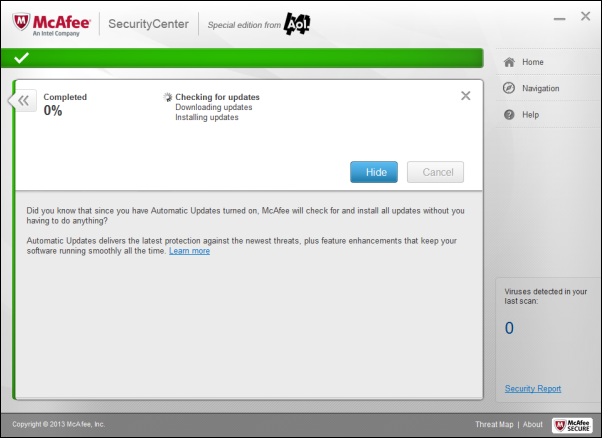

I’ll let you have it if you want that, but it’s a little too complex for this simple task. At first, I created a VB script on the fly (using echo commands) that I then invoked, just to be able to convert an hex to a decimal value. But I had to compare it to a decimal value and both are in environment variables, which are character strings. This is a DWord value that reg.exe will display as some Hexadecimal number. Note that this may not be the actual value for YOUR version of VirusScan… HKLM\SOFTWARE\McAfee\AVEng ine\AVDatV ersion In my case (VirusScan 8.7 I think), this is the binary value stored here: Retrieving the current version level of the DAT file is quite easy, with some registry mining. So I decided that it was better to check for the current version level of the virus signature (that McAfee calls DAT files) and to compare it with the “newer” one that McAfee provides on its site.
+months_Page_3.jpg)
#Update mcafee superdat download
Even too simple: It will download SuperDAT even if the current virus signature is already installed on the computer running the script.
#Update mcafee superdat .exe
exe file, which can run silently and which updates McAfee’s antivirus systems (virus definitions AND engines).Ĭd %temp% if not exist McAfee\nul md McAfee cd McAfee if exist gdeltaavv.ini del gdeltaavv.ini wget if not exist gdeltaavv.ini goto error1 for /F "usebackq skip=2 delims= tokens=1,2*" %%m in (`Find /I "CurrentVersion" gdeltaavv.ini`) do set Curr=%%n if exist sdat%Curr%.exe goto fin del *.exe wget if not exist sdat%Curr%.exe goto error2 sdat%Curr%.exe /silent goto fin :error1 echo Cannot retrieve gdeltaavv.ini goto fin :error2 echo Cannot retrieve sdat%Curr%.exe goto fin :finĪs you can see, this script is very simple.
#Update mcafee superdat for free
Wget is used to get the SuperDAT utility that McAfee provides for free on its update servers. So I created a script that should be usable on most of the Windows systems that use McAfee virusscan. I came across several sources on the web, but the one that was really helpful was: Since I was in a hurry and could not spend too much time debugging McAfee’s product, I decided to create a simple script and to make sure it was launched often enough. The IT/Security team for their corporate IT/network had specified to use McAfee’s public update servers at the end of the list of update servers, but for some reason, it was not working as expected. And their “anti-virus update servers” are on said intranet.

And this was my primary reason for developing this utility: Some of the users I had to support were not connecting often enough to their corporate intranet. It can also be a very nice thing to be able to do that when the normal/automated update does not work. Or when the computer has been idling for a certain amount of time. Why is it useful to be able to update an Antivirus from the command line?īecause it lets you control the schedule of this process.įor instance you can decide that you want to try to update each time the computer is booted. I thought I’d share my experience with you. I recently had to create a utility which aim is to update McAfee's Virusscan and that had to be launched from a command line.


 0 kommentar(er)
0 kommentar(er)
